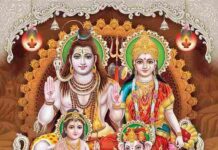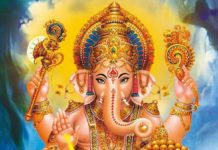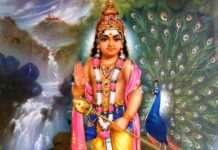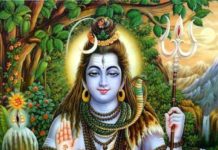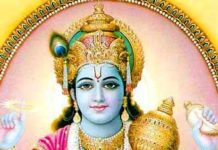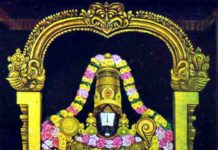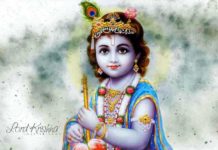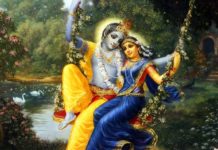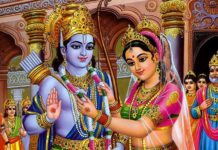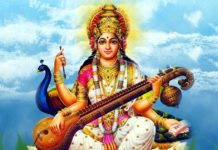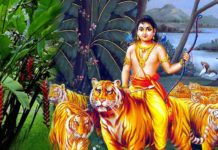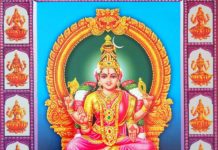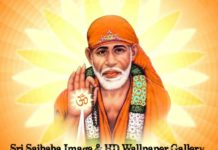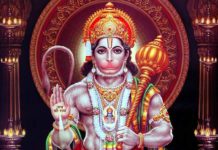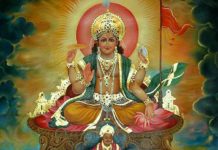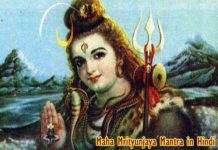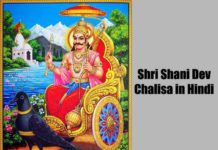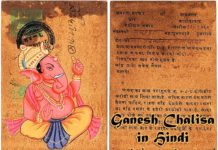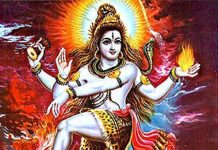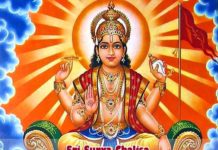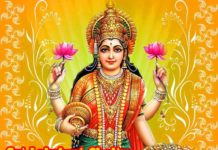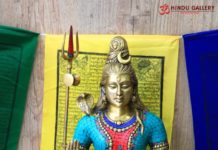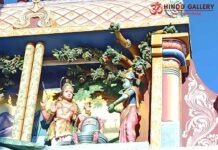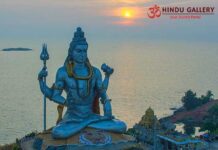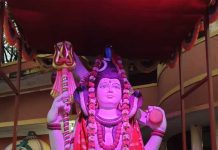Sri Kamakshi Amman Temple is situated at Kanchipuram, Tamil Nadu. This temple is ascribed for Sri Kamakshi Devi, one of the manifestations of Sri Parvathi Devi. It is believed that the temple was built in Pallava era in 6th Century A.D.
Sri Kamakshi Amman Temple is the one and only temple having the sanctum of Sri Parvathi Devi as Sri Kamakshi. In all the 108 Shiva temples situated at Kanchipuram, there is no dedicated shrine for Ambal. At Kanchipuram, Ambal can be worshipped only at Sri Kamakshi temple.

Sri Kamakshi Amman – Legend
There are a few legends pertaining to the origination of Sri Kamakshi Amman.
The term “Kamakshi” means the person with lovable eyes. As per the legend, “Ka” denotes Sri Saraswathi Devi and “Ma” denotes Sri Mahalakshmi. Hence Sri Kamakshi is said to have both Sri Saraswathi and Sri Lakshmi as Her eyes.
Penance
Sri Parvathi Devi had done penance here by making a Shiv Ling with the mud on earth. Lord Shiva had desired to test the level of penance of the Devi. So, He took the form of a river Kambam and with the high tides, tried to destroy the Shiv Ling. However, Sri Parvathi Devi had protected the Shiv Ling with both Her hands.
Sri Parvathi Devi as Sri Kamakshi had also done penance on the tip of the needle surrounding Herself with five types of fire called Panchagni. Lord Shiva was pleased with the penance done by Sri Kamakshi and married Her on Panguni Uthiram day.
Arupa Lakshmi
As per the legend, once Lord Maha Vishnu had cursed Sri Lakshmi to go formless. She had done penance here on Sri Vishnu for the alleviation of the curse. It is believed that offering the Kumkum of Sri Kamakshi to Arupa Lakshmi shall bestow wealth.
Dasaratha
It is believed that King Dasaratha offered prayers to Sri Kamakshi here before doing Puthra Kameshti Yagna for begetting children.
Mooka Kavi
Once there was a speech challenged person named Mooka. He was ardent devotee of Sri Kamakshi. He sincerely prayed to Her for speech. With the blessings of Sri Kamakshi, he had become a poet and composed Mooka Pancha Sashti comprising of 500 poems.
Adi Sankaracharya
Earlier, Sri Kamakshi Amman was known as Ugra Swaroopini (fierce). Sri Adi Sankaracharya had worshipped Sri Kamakshi as Sri Lalitha Parameshwari / Sri Lalitha Tripura Sundari / Sri Kamakshi Para Bhattarika.
He had established the Sri Chakra at the main sanctum of this temple in a channel like structurre. After the installation of Sri Chakra, Sri Amman had taken the appearance of Shantha Swaroopini (calm and peaceful Goddess).
Sri Shankara had composed Soundharya Lahiri in praise of Sri Ambal.

Gayathri Mandapam
The main sanctum is called as the Gayathri Mandapam.
It is believed that the four walls of the Mandapam represent the four Vedas. The twenty-four pillars are said to represent the twenty-four syllables of Sri Gayathri Mantra.
Bila Dvara
The Bila Dvara is said to be inside the main inner sanctum. As per belief, Lord Shiva Himself had taken the form of Sage Durvasa and worshipped Sri Paramba on Her emerging. He is said to have prayed to Her as per Shri Vidya Thanthra.
He is also said to have installed the Sri Chakra here as Sri Adi Sankara. Thus, Sri Adi Sankara had installed Her as Sri Guru Murthy Svaroopini. The depiction of Vashinyadhi Vaakdevatha is inscribed around the Sri Chakra.
Sri Paramba
As per the legend, when Bhadasura was torturing Devas, they took the form of parrots and stayed at Shenbaga vrukshas at Kanchi. They did penance on Sri Shakthi.
Shakthi had then emerged as Sri Paramba through the Bila Dvara door and destroyed the demon. She sits in Yonasana. She faces south east.
Sri Paramba is said to be present in three manifestations. The first one is sthula, the physical yogic attribute, the second is sukshma, the invisible manthric attribute and the third is karana, the hearing attribute.
As per the legend, Lord Shiva himself had worshipped Sri Paramba for four yugas in the forms of Sages such as Krodha Bhathraka, Parashu Ram, Dhaumya and Adi Sankara.
Sri Brahma had presented Her to the universe as Sri Kamakshi, as the consort of Sri Kameshwara, Lord Shiva.

Sri Kamakshi
Sri Vidhya Parameshwari is considered as the core of Prakata Gayathri and She is said to be enshrined here as Sri Kamakshi, the main Deity.
Sri Kamakshi is on Pancha Brahmasana posture. She has four hands. The upper hands hold pasha and ankusha. The lower hands hold sugarcane bow and flowers arrow.
A parrot is also depicted to perch on the bunch of five flowers kept as the arrow. Her sitting posture is said to signify peace and prosperity.
Thapa(s) Kamakshi
Sri Kamakshi appears in the penance form in the right side of the main Deity. As per the legend, when Sri Uma Devi got separated from Lord Shiva, She was in Kashi as Sri Annapurna.
As suggested by the Sage Kathyayana, She came to Kanchi to do penance on Lord Shiva under the mango tree. The tree still exists in Sri Ekambareswarar Temple at Kanchi.
Anjana Kamakshi
She is also called as Arupa. Her shrine is to the left of the Main Deity. She is facing north. Her Shrine is in front of Saubhagya Ganapathi. Ramaa, the Goddess Mahalakshmi is believed to have done penance here.
Kunkuma offerings to the Main Deity are offered to this Deity before distributing to the Devotees. This Deity represents Ramaa in Ramaa-bija and as Kamakshi, She represents Kamaka-lakshara.
Other Shrines
There are other Shrines inside the temple premises.
Divya Desam
In the Gayathri Mandapam, there are shrines for Sri Varahi, Sri Arupa Lakshmi, Sri Ganapathi and Sri Kalvar Perumal. Here the sanctum of Sri Kalvar Perumal is considered one of the 108 Divya Desams of Sri Maha Vishnu.

Prakaram
There are dedicated shrines for Sri Iyappan, Sri Anna Purani and Sri Adi Sankaracharya in the Prakaram.
In the outer Prakaram, there are shrines for Sri Kala Bhairavar, Sri Mahishasura Mardhini and Sri Kasi Viswanathar.
Bangaru Kamakshi
At the second precinct of the temple, there is a separate shrine for Sri Bangaru Kamakshi who is also called as Svarna Kamakshi.
As per the legend, Sri Bangaru Kamakshi had emanated from the third eye of Shri Vidhya Parameshwari. She is called as the Shakthi Ekambika of Sri Ekambaranatha.
The original of the Vigraha was sent to Thanjavur to protect it from the invaders. The Vigraha in this temple is the replica of that.
Urchava Kamakshi
The Shrine for the processional Deity is situated in the second precinct. The Urchava Murthy of Sri Kamakshi is accompanied by Sri Sharada, the incarnation of Sri Saraswathi and Sri Ramaa, the incarnation of Sri Mahalakshmi.
As Sri Kamakshi Herself is Shiv Sakthaythmika, there is no separate sanctum for Lord Shiva in this temple.
Sage Dhurvasa
There is a dedicated shrine for Sage Dhurvasa. He is one of chief upasakas of Devi. He had consecrated Bhu-Prastara Sri Chakra in front of Sri Ambal.
He had composed Sri Lalitha Stava Rahna, Shakthi (Thaipura) Mahima Stotra and Para Shambu Mahima Stotra.

Others
In the third precinct of the temple, there are dedicated shrines for Sri Hayagreeva and Sri Agasthya. It is believed to be the exact place where the Slokam Lalitha Trisathi was composed.

Timing and Rituals
The temple opens up at 5.30 A.M with Gau Puja. The temple is open for Devotees from 06.00 A.M to 12.00 Noon and from 04.00 P.M to 08.30 P.M. Abhishekams are done at 05.00 A.M, 12.00 Noon and at 05.00 P.M. Sahasra Nama Archana is done daily from 07.00 A.M to 12.00 Noon and from 06.00 P.M to 08.00 P.M.
On Pournami day, Navavarna Puja is done at 10.00 P.M. On Wednesdays and Saturdays, Sangal Alankaram is done by 06.00 P.M.
The timings may vary during festivals and special occasions.
Festivals
The Fridays of Aadi month and Thai month are festival days. Apart from these, the following festivals are observed.
-Vasanthorchavam (Spring festival) in Masi month (February – March).
-Navarathri
-Aadi and Aipasi pooram
-Vaikasi Vasantha Uthsavam
-Adi Kamakshi Amman
Sri Adi Kamakshi Amman
There is another temple nearby dedicated to Sri Kamakshi. This temple is called as Sri Adi Kamakshi Amman temple.

The presiding Deity is Sri Kalikamaba. There is a belief that Sri Sankarcharya would have pacified the Shakthi at this place. All the rituals followed at Sri Kamakshi Amman temple are followed here as well.
How to reach
Kanchipuram is easily accessible from Chennai. Trains and buses are available at regular frequency. Call Taxis can also be booked.





